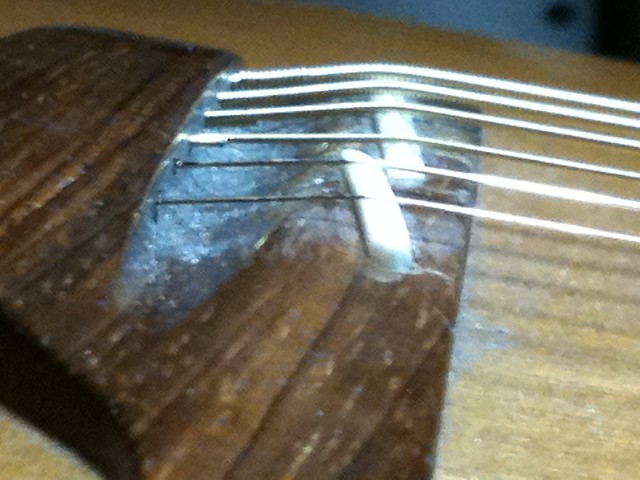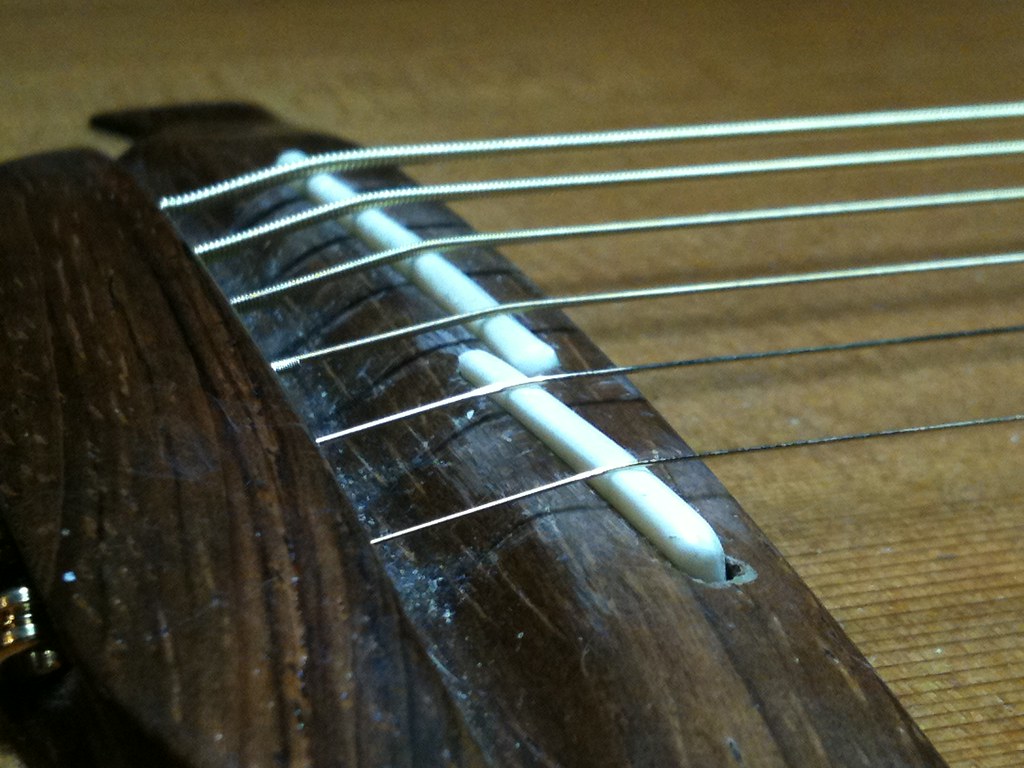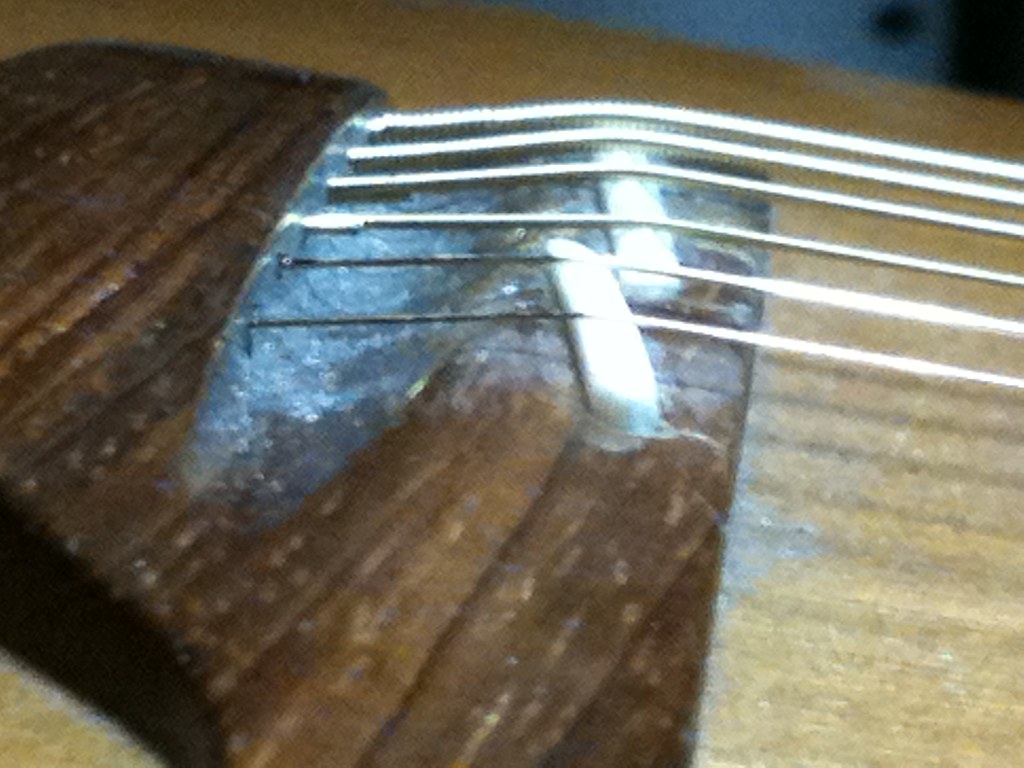
 |
|
#1
|
|||
|
|||
|
I think I posted this in the wrong forum originally since it clearly belongs in Build and Repair. A thousand pardons for the double post.
A while ago I bought a 2001 Lowden O10 off this forum and was quite happy with the quality of the tone in general. The guitar in question had been well played with superficial pick marks in the top, the odd minor dent, and some signs of wear just south of the pickguard. All of these things being superficial there being absolutely no cracks or structural problems I take it that the guitar was more or less cared for but certainly gigged. Something that has recently come to my attention through some increased quality time with said guitar and the opportunity to A/B it with a slightly older O10 (1999). I noticed that the action was unusually low. Not having owned a Lowden before, I was ignorant of the ideal string break angle. The unusual split saddle design made me believe I was just ignorant to the design. However, I noticed the older O10 had considerable more volume and presence. I examined the bridge on the slightly older 010 and it's clear that the string break angle on both the treble and bass saddles were steeper. Also, it appears that the strings were sitting higher in the nut on the older one than on my O10. In short, the older one had stock action and it felt just fine. My O10 buzzes occasionally and I think the string is jumping on the saddle for the trebles. So the question to you Lowden luthiers and general experts out there is this: Do I get a new nut with slightly higher action cut as well as a new higher saddle? A 3mm action increase is fine with me. The bonus question is: do you think this was a progressive step (nut groove shaving and then saddle shave) or do people just brutalize their guitars like this on a regular basis? Attached are pictures of MY O10, the one with the problem. I didn't have a chance to take pictures of the 1999 O10. Please note that there is a chunk out of the bridge where some cowboy took the original saddle and swapped with an identical height (I have the old ones) bone saddle. Pictures: http://www.flickr.com/photos/raveged...7626071608096/    Thanks |
|
#2
|
||||
|
||||
|
Yep, that saddle is too low. Best bet is to take it to a guitar tech for a complete action setup. It is not very expensive to have that done.
__________________
Derek Coombs Youtube -> Website -> Music -> Tabs Guitars by Mark Blanchard, Albert&Mueller, Paul Woolson, Collings, Composite Acoustics, and Derek Coombs "Reality is that which when you stop believing in it, doesn't go away." Woods hands pick by eye and ear
Made to one with pride and love To be that we hold so dear A voice from heavens above |
|
#3
|
|||
|
|||
|
Quote:
2. If you can tolerate a 3 mm increase (measured at the 12th fret), that translates to 6 mm increase in the height of the saddle. That should be enough to restore a steeper break angle of the strings over the saddle. 3. Bonus question: it is not uncommon for people to "brutalize" their guitars on a regular basis. Truth be told, many of the basic setup related tasks can be quite successfully undertaken by anyone who is a little "handy" AND who takes the time to learn what needs to be done. In this regard, I'll flog my Basic Guitar Setup 101 again: http://web.me.com/charlestauber/luthier/Home.html. 4. The bearing (top) surface of the saddle in your guitar is too flat, likely allowing the string to vibrate side-to-side across the surface. Making the point of contact more acute by removing material from the saddle before and after the point of contact will reduce this. |
|
#4
|
|||
|
|||
|
IMO the height of those saddles doesn't appear THAT low - break angle can be tricky to evaluate on guitars with pinless bridges. Picture your guitar with bridge pins - the string would come off the saddle and take a much steeper angle into the bridge.
I didn't get a chance to play this guitar, but I was very close to buying it. The seller lives about 20mins from me. This guitar was a great deal, so go the extra mile and get a proper setup done  The treble saddle does look a bit flat on top, and a tech will be able to determine if your nut is too low as well. The treble saddle does look a bit flat on top, and a tech will be able to determine if your nut is too low as well.Lowdens deserve love! Good luck with it 
__________________
Bown OM |
|
#5
|
|||
|
|||
|
Rick & Charles,
I'm a little confused. Wouldn't increasing the nut height potentially cause one problem to solve another. Increasing nut height would make the 1st position action more difficult to play and potentially the real problem with this saddle height and break angle may be the neck angle? |
|
#6
|
|||
|
|||
|
Quote:
And yes, this Lowden is definitely worth it. I know there is more tone to be had and despite the complications, I still love playing it. Last edited by limnephilidae; 02-17-2011 at 02:01 PM. |
|
#7
|
|||
|
|||
|
Quote:
Anyway, thanks for the links, those are really informative. I make regular action adjustments myself but I recently lost my workshop when I moved into a more urban environment. I would take nut and saddle adjustments to a luthier. In this case I am not confident about making the right decision of using a shim or getting a new nut/saddle and I couldn't cut new ones without the proper equipment anyway. Last edited by limnephilidae; 02-17-2011 at 02:08 PM. |
|
#8
|
|||
|
|||
|
Quote:
The action is arguably a little too low right now anyway. But with regards to your point about the nut height, I am really not sure and I trust an experienced luthier will evaluate this correctly when they see it in their hands. As far as I can tell the neck angle looks good and there doesn't seem to be any serious bellying around the bridge. The Lowden necks themselves are pretty stiff and I think they are very tightly glued in the joint. At any rate, I will take this to a good luthier and defer to an actual expert (of which I am decidedly not). |
|
#9
|
|||
|
|||
|
Quote:
 The guitar maker chooses what amount of the saddle will protrude from the bridge - or, alternatively, the string height above the guitar top - they want an instrument to have. (Most makers aim for at least 1/16" to exert enough downward pressure to prevent the strings from vibrating side-to-side across the top of the saddle.) That, along with fingerboard thickness, fret height and intended action (string height above the frets), determines the necessary neck angle. If the setup of the instrument varies significantly from the maker's intended values - fingerboard thickness, fret height, action... - the saddle height will vary accordingly. If the action, for example, is significantly less than was intended, the saddle will be lower by a factor of 2. The original poster stated that the action was quite low at both nut and saddle. Hence, a good place to start. |
|
#10
|
|||
|
|||
|
Thanks Charles. That makes sense. I guess my bias is that, if I'm not getting string buzz, I'm generally going to be loath to mess with the nut assuming action there is very playable. Of course adjusting the nut is preferable to a neck reset if there is not really a neck angle issue.
|
|
#11
|
|||
|
|||
|
UPDATE
I took this in to the 12th Fret and we agreed to try just a truss rod adjustment. I will play it for a little while longer before I decide to raise the action to suit my preferences. Note: I was wrong about the string bouncing on the saddle, the truss rod adjustment was enough to relieve the buzzing. The buzzing was definitely caused by fret contact due to the low action. The nut and saddle are on the "lowest end of the recommended spectrum" and "only suitable for fingerstyle". Quotes from a luthier who probably has as many years experience as I've been alive. Thanks again to everyone's advice. Hopefully this exchange helps others out. |